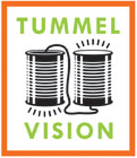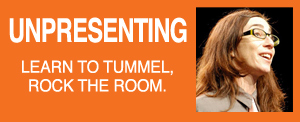All posts tagged kevin marks
TummelVision 69: Dan Gould on Namesake, conversation, and schooling the New York Times
Podcast: Play in new window | Download
Episode Notes
Dan Gould is founder of Namesake, a new online business community centered around conversations. He joins Heather Gold, Kevin Marks, and Deb Schultz to talk about the project, as well as recent events at the intersection of tech, culture, and people. Check out the Namesake conversation about Tummeling and revisit the live chatroom discussion from Cover It Live.
TummelVision 68: Sarah Szalavitz on story, social design, Hollywood and imposters
Podcast: Play in new window | Download
Episode Notes
Sarah Szalavitz (@dearsarah) does social design under her company Robot7 and teaches at the MIT Media Lab. Her background was in law and then Hollywood. A self-described “champagne socialist,” she did deals for Michael Eisner’s web video venture Veoh and has been one of the key people connecting filmed entertainment to the network economy. Her focus is now much broader than Hollywood and she focuses on systems and questions. As she says “now everyone makes media….how do we encourage people to participate.”
Storified notes from the conversation are here.
TummelVision 65: Open House!
Podcast: Play in new window | Download
Episode Notes
Regular TummelVision chat room contributor @Xenophrenia joins in a discussion of open source, copyright, economics, and more in this first ever “Open House” episode. We hope to make a regular feature out of this kind of episode (our version of a call-in hour).
News and Notes:
- Kevin Marks has dubbed Deb Schultz a “knowledge bricoleur“
- Video of Kevin’s Ignite talk at Google i/o
- How to Stop Worrying and Learn to Love the Internet – Douglas Adams writing in 1999
- Tyler Cowen’s new book The Great Stagnation: How America Ate All The Low-Hanging Fruit of Modern History, Got Sick, and Will (Eventually) Feel Better
- Films by writer and chat room regular Tony Comstock
- Good Manners in the Age of Wikileaks – Slavoj Žižek in the London Review of Books
- Eli Pariser’s TED talk on the internet’s “filter bubble”
As you listen, you can replay the fascinating conversation from our live chat room here at CoveritLive.
TummelVision 59: Thomas Knoll on love, community architecture, Zappos, tech, and humanity
Podcast: Play in new window | Download
Episode Notes
Thomas Knoll joins Heather, Kevin, and Deb to talk about love, community architecture, Zappos, tech, and humanity.
TummelVision 53: Molly Steenson on pneumatic tubes, the links between architecture and social software, and creating meaning without shipping code
Podcast: Play in new window | Download
Episode Notes
This week’s guest is Molly Steenson, a digital strategist, design researcher, architectural historian and Ph.D. candidate at Princeton University.
Molly joins Deb Schultz and Kevin Marks to discuss the implications of IBM’s Watson winning jeopardy, the hidden links between architecture and interface design, and whether “shipping code” is the only measure for creating value.
A few links we discussed in this episode:
- Don Norman, “I have seen the future and I am opposed” – walled gardens and over reliance on tech
- OM Malik, “Change Is Good, But It’s Also Really Hard”
- Ten Mindful Ways to Use Social Media– the human side of how to engage
- TummelVision Ep. 40 guest Dave Gray on Company as organism
- “The Meet Ben Fisher, The Hard Drinking, No Bullshit, Tech Fixer for SXSW” – Tummeling as job description
- TED Conversations launches: Sign of the increasing importance of Tummeling skills moving online
Molly’s work in her own words
“I’m writing about interactivity and its origins in architecture — human-computer interaction in architecture and urbanism. Right now, I’m focusing on Nicholas Negroponte, the founder of the MIT Media Lab. He was trained as an architect and then founded the Architecture Machine Group at MIT in 1968 (which later became the Media Lab in the 1980s). He tried to apply big ideas of artificial intelligence to architecture and urban planning. Think of Watson winning on Jeopardy — now imagine a Watson that could design cities and buildings in a close relationship with a person. That’s what Negroponte had in mind in the 60s and 70s. Obviously, the technology simply wasn’t advanced enough to do it — but the thinking was provocative and really interesting.The interesting thing to me is that figures like Negroponte, Christopher Alexander (who wrote A Pattern Language) and Richard Saul Wurman (who coined the term “information architecture and founded the TED conference) are all architects by training who had a major impact on our digital worlds. Alexander’s idea about patterns were important for object-oriented programming languages, not to mention for game and interface design. Wurman is one of the godfathers of contemporary information architecture. I wonder why these architects didn’t fit well into the field of architecture but mesh so well with the ways we design today for interactivity.
Outside of my academic work, I’m also interested in mobility, mobile phones and future-casting research. I’ve spent a summer in India researching how people share mobile phones — and as we look at sustainable ways of using objects, sharing gets to be important. I’m working on an amazing project with the Institute for the Future that I can’t talk about… I’ve looked at how friendship is changing in China and England thanks to social networking sites.”







